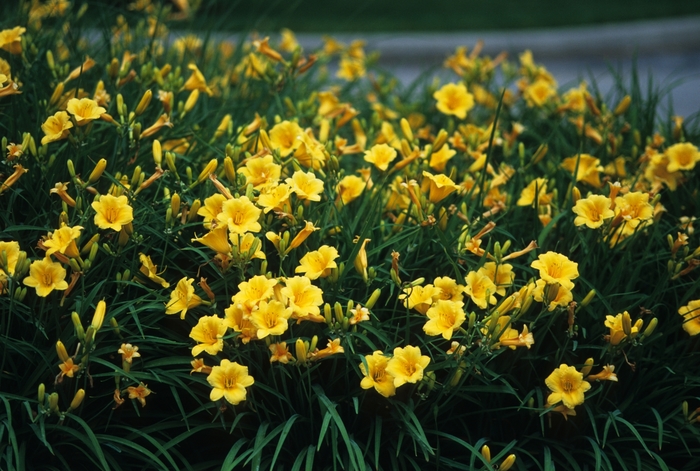« Previous Plant | Next Plant »
Hemerocallis (Daylily)
'Stella d' Oro'
The world's most popular daylily! 2.75, bright gold flower with mild pie crust edging and a subtle fragrance. Begins blooming in early summer followed by waves of rebloom into early fall (reblooms best if plants are deadheaded). Performs superbly in the landscape; great for edging.
- » Long-blooming, award winning daylily
- » Yellow flowers with ruffled edges
- » One of the most popular varieties
Daylilies can survive many harsh conditions that other plants cannot including: polluted city environments, slopes, poor and dry soils, near pavement that is salted in winter, and under Black Walnut trees (not affected by juglone). Daylilies are some of the easiest perennials to grow and are a good choice for any gardener, from the beginner to the professional. These are tough, adaptable plants that will grow in any soil, from normal to slightly wet to dry. All varieties can be divided every 3-4 years by digging up the entire clump and dividing it into smaller pieces with a minimum of 3 eyes each. This can be done in either spring or fall. Plants should be deadheaded for cosmetic purposes, but in most cases this will not extend the bloom time.
- Height
- 10 - 12 in
- Spread
- 10 - 12 in
- Zone
- 3-9
- Color
- Gold
- Categories
- Perennial
- Tags
- Border or Bed; Container; Cut Flower/Foliage; Fast Growing; Fragrant; Low Maintenance
Check back soon for additional information on 'Stella d' Oro'.
Daylilies can survive many harsh conditions that other plants cannot including: polluted city environments, slopes, poor and dry soils, near pavement that is salted in winter, and under Black Walnut trees (not affected by juglone). Daylilies are some of the easiest perennials to grow and are a good choice for any gardener, from the beginner to the professional. These are tough, adaptable plants that will grow in any soil, from normal to slightly wet to dry. All varieties can be divided every 3-4 years by digging up the entire clump and dividing it into smaller pieces with a minimum of 3 eyes each. This can be done in either spring or fall. Plants should be deadheaded for cosmetic purposes, but in most cases this will not extend the bloom time.
